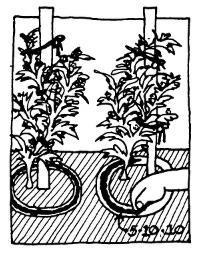Tomatoes need quite a big food supply over the season -- they're what we call "heavy feeders." This is no surprise when you look at all the work they're doing: extending the stem, putting out more branches, leaves and blossoms; developing, nurturing and ripening all those fruits! To do all this work they need a steady diet of water and nutrients.
All About Side-DressingIn most gardens, it's a good idea to side-dress tomatoes. That simply means placing fertilizer around the plants to give them extra nourishment through the season. One or two side-dressings is fine for most gardens.
Many kinds of fertilizers can give tomatoes the extra nutrients they need. Some gardeners prefer to use a complete fertilizer (such as 5-10-10 or 10-10-10). Organic fertilizers such as bone meal, dried manure or cottonseed meal are also good. Just remember that most organic fertilizers don't contain balanced amounts of the three major nutrients - nitrogen, phosphorus and potassium. For example, manure tends to be low in phosphorus so you could add bone meal at the same time to provide a more complete diet.
Stay away from high-nitrogen fertilizers such as urea, ammonium sulfate or fresh manure because it's easy to use too much. When you over fertilize, you get tall, dark green plants with few tomatoes.
Start side-dressing when the first tomatoes have just formed - when they're about the size of golf balls. Make repeat side-dressings every three weeks after that. About a pound (two cups) of 5-10-10 should be enough for all the plants in a 30-foot row (about 20 plants). This works out to about 1-1/2 tablespoons per plant spread in a one-inch-deep circular furrow five to six inches away from the stem, usually right under the drip line of the plant. Be careful not to get any of this fertilizer on the leaves or stem because it will burn them. Cover the fertilizer with one to two inches of soil. The next rain or watering will start carrying the nutrients down into the root zone of the plants.

 Victory Seed Company has all the seeds you want for your best garden in 2024.
Victory Seed Company has all the seeds you want for your best garden in 2024.
For 25 years, the family-owned Victory Seed Company has provided the highest quality vegetable, herb and flower seeds to families across the country. We are passionate about providing you the best seeds available that give excellent germination, robust plants, and the harvest you want. With a catalog of over a thousand varieties, we have everything, and our prices are the kinds that we'd want to pay. We have hundreds of yesterday's heirloom vegetables, as well as today's award winning hybrid selections. Get to know us by visiting our website and browsing through our online vegetable seed catalog.
| 1. Pruning Tomatoes |
| 2. Mulching Tomatoes |
| 3. Fertilizing Tomatoes ← you're on this article right now |
| 4. Watering Tomatoes |
| 5. Tomato Problems |
| 6. Insect Pests of Tomatoes |
| 7. Tomato Diseases |
| 8. Supporting Tomatoes with Cages |
| 1. Pruning Tomatoes |
| 2. Mulching Tomatoes |
| 3. Fertilizing Tomatoes ← you're on this article right now |
| 4. Watering Tomatoes |
| 5. Tomato Problems |
| 6. Insect Pests of Tomatoes |
| 7. Tomato Diseases |
| 8. Supporting Tomatoes with Cages |